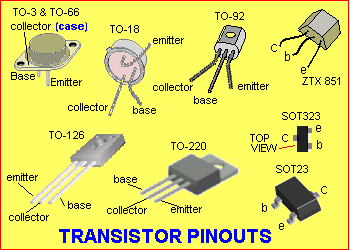|
Transistor Data |
|
CLICK
HERE FOR |
|
CLICK
HERE FOR |
Here are some links to data-bases on the web:
Philips SM transistor markings
Transistor Database
SMD
Markings - very large database
www.ecadata.de - a very large
database with reference to suppliers and prices.
Philips SM transistor markings
See
Page 56 of
our Basic Electronics Course UJT
See
Page 57 of our Basic
Electronics Course
Voltage Regulator
See
Page 64 of
our Basic Electronics Course
Testing Diodes
See
Page 65 of
our Basic Electronics Course
Testing Zeners
See
Page 66 of our Basic
Electronics Course
Testing transistors
This article is part of Page 66 of our Basic Electronics Course. The full Basic Electronics Course is available via subscription.
Here are the most common pinouts for transistors:

SUBSTITUTING TRANSISTORS
There is no simple answer to finding a replacement for a transistor.
There are thousands of types, shapes, sizes and specifications.
But if you take things slowly and methodically, you can generally find a replacement quite easily.
There are two reasons why a transistor needs to be substituted.
A. You may be building or designing a project and not have the exact specified type, or
B. You may be repairing a damaged project, and the original type is not available.
Don't worry too much about getting the exact equivalent. Most circuits will operate with almost any substitute. I know this is a bold statement but it's the only way to approach the situation.
There are many transistor-types and numbers on the market and they came about due to "batching" - not because of a radical improvement .
Batching is the process of grading a transistor due to a particular characteristic, such as maximum collector-emitter voltage before "zenering" occurs, - another term for "breakdown" or failure. Originally it was difficult to produce transistors with a high operating voltage and every transistor had to be tested. The good ones were sold with a "commonly-recognized" part-number and the others had a different part-number.
Also, the gain of the transistor was determined, so a higher price could be obtained, and the transistor was given a pre-fix "-A," "-B," "-C," etc.
Then JAPAN came into the picture.
They perfected transistor manufacturing.
They increased the operating voltage enormously, improved its reliability and totally revolutionized the electronics market.
That's why you have to be very careful when replacing a Japanese transistor.
Some Japanese circuits operate on a high voltage and only a Japanese transistor can be used.
But apart from that, our simple approach can be used.
Firstly you need to work out if the transistor has been damaged by overheating or from a voltage spike.
A transistor will accept overheating for a considerable length of time,
but will be instantly damaged by a voltage spike.
Check for the possibility of spikes. They will be present if the
transistor is driving a coil or inductor.
If the transistor has been damaged by overheating, you may see heat-damage on the PC board.
Of course you will have to decide if another area of the circuit has
created the fault and damaged the transistor.
That's outside this discussion.
Secondly, you need to determine if the transistor is NPN or PNP.
This is difficult to do if the transistor is damaged, as it cannot be
tested. But if the transistor-type can be determined, this is your
starting-point.
You must replace an NPN transistor with an NPN type.
Thirdly, you need to determine if the transistor is a low power
type,
medium power or high power. This can be easily done by
viewing the size of the
transistor.
Some of the outlines are shown above and nearly ALWAYS the size of the
transistor determines its "power rating" - the amount of current it will
handle.
From these three determinations, you have already narrowed the field to
a very close replacement.
The three things you cannot determine from simply looking at a
transistor are:
The voltage rating,
The gain, and
The maximum frequency it will operate at.
These can be obtained from the circuit.
With these facts you can go to a replacement chart and find a suitable
device.
All you have to do is find the cheapest device and if it is available.
It all sounds so simple and if you do things in the order suggested
above, you will invariably come up with a replacement.
- Colin
1-1-2012